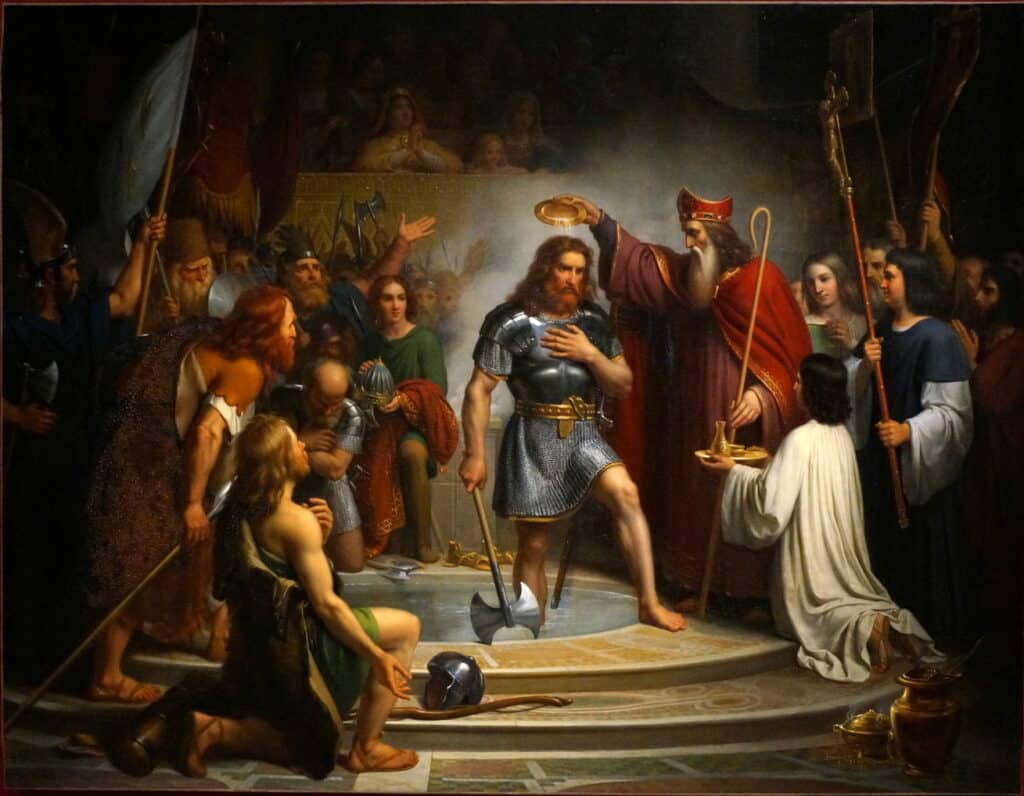In the world of medieval Europe, there were many kingdoms that rose and fell, shaping the course of history both in their existence and in their destruction. In this time of kings and queens, some figures rose above the rest.
One such figure is Clovis I, a king of France who is regarded as the origin of the French monarchy and the first Germanic king to convert to Catholic Christianity.
Originally a pagan when he first claimed France as his own, Clovis was brought into the Catholic fold by both his wife and the impression that God answered his prayers during a pivotal battle.
Clovis accomplished the impossible–uniting all the tribes of France under one flag–his own. As the founder of the Merovingian dynasty, he succeeded in unification where everyone else had failed. Let’s look a little deeper into the fascinating history of Clovis I

The Early Life of Clovis I
Clovis I was the son of the king of the Salian Franks, Childeric I, and a Thuringian queen, Queen Basina.
His father was an infamous figure in his own right, having been exiled to Thuringia for “debauchery”. While in exile, he caught the eye of Basina, the wife of the Thurginian king Bisinus.
Apparently not too worried about spurning his host, when Childeric returned to the northern portion of the Roman Gaul, he brought with him Queen Basina.
Basina, too, made a name for herself. Once she returned with Childeric, it’s said that she took it upon herself to propose to the king of the Franks, having no interest in waiting for Childeric to make the move himself. They were married, and she bore Childeric four children.
The children of Childeric I and Queen Basina were:
- Clovis I (466-511)- First king of France
- Audofleda (467-511)- Queen of the Ostrogothic Kingdom and the wife of Theodoric the Great, King of the Ostrogoths.
- Lantechildis (468-unknown)- Frankish noblewoman and eventual Catholic convert.
- Albofledis (470-unknown)- A Frankish noblewoman who was baptized on the same day as Clovis I, her brother.
Clovis I Ascends the Throne
When Clovis was only 15, his father passed away. This left the young teen with the responsibility to take his father’s place, and as the only male heir, he was soon crowned king of the Salian Franks as well as other groups of Frankish people around Tournai, which is now a part of Belgium.
All around the new King Clovis I, the world was changing. The Roman empire was on the decline, and being invaded from all sides by different enemies, such as the Huns and the Ostrogoths.
At the time, the region in which Clovis ruled, Gaul, was under Roman control, but it wouldn’t be long before Rome lost not just Gaul, but all of their other territories in the west.
Ten years into Clovis’ reign, the Western Roman Empire fell. In the wake of the destroyed giant, all of the tribal kings that had previously been under Roman control scrambled to claim a portion of the old Roman empire for themselves.
One of these kings would be Clovis I, but unlike so many of the others, Clovis was not only successful, but he would found a family dynasty that would stick around for over two hundred years.
The Reign of Clovis I
Early in Clovis’ reign, he began to grow his realm, finding allies in other barbarian kings Ragnachar and Chalaric. With all three kingdoms combined, Clovis initiated the march on the Roman-ruled city of Soissons.
Soissons was the last bastion of Roman rule in Gaul, with a Roman general named Syagrius acting as the leader of the area. Despite one of Cloivs’ allies, Chalaric, betraying him, the Franks still gained a tidy victory over Syagrius, and Rome was ousted from the area completely.
From there, Clovis I continued to capture nearby Roman territories and cities, bringing them under his rule one by one. Clovis was a pagan and had no qualms about ransacking churches, taking the valuables within, and leaving ruin behind.
But the catholic clergy was not a force to be taken lightly, and Clovis soon discovered that he would not be able to rule Gaul unless he had the clergy on his side. To satisfy the church, he took a Nicene Christian wife to prove his loyalty. This wife, Clotilde, would change the course of Clovis’ life in ways he didn’t expect.
Battle of Tolbiac and Clovis I Converts to Catholicism
One story explains that Clovis’ wife, Clotilde, had their first son baptized but that the boy died soon after. The king refused to let his next child be baptized, but his wife had one conducted in secrecy. The second son fell ill but eventually recovered.
Not long after this, Clovis found himself at a huge disadvantage during the Battle of Tolbia. In a moment of enlightenment and desperation, Clovis prayed to his wife’s Christian God, calling to the sky,
“If thou grant me victory over these enemies…I will believe in thee and be baptized in thy name.”
After this prayer, the tides of battle turned and Clovis was victorious. The king kept his word and was baptized at the Abbey of Saint-Remi.
Defeat of the Visigothic Kingdom
To expand his territory more, Clovis went to battle with King Alaric II, King of the Visigoths, in 507. Clovis was again successful, and adding the Visigothic Kingdom to his empire greatly increased its size.
With this victory, Clovis held authority over a large amount of Gaul, and his next move would be to unite all the smaller Frankish tribes under his name.
Unification of the Frankish Tribes and the Legacy of Clovis I
Clovis successfully united a number of Frankish tribes, further extending his reach through the Gaul and into areas of modern-day Germany. With this unification, an area that had previously been divided into many smaller kingdoms was now one massive empire, with Clovis I ruling over it all.
Clovis I’s kingdom was the precursor to the country we now know as France. He named Paris as his capital, and it remains the capital of France today.
All of this led to him going down in history as the first King of France, the founder of the French Monarchy, and the first Catholic Germanic king.
King Clovis I died either in 511 or 513 and his kingdom was split between his four sons. These sons would do little to continue to expand the Frankish kingdom, but by passing his rule down, he continued the Merovingian dynasty that would last until 751.

